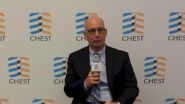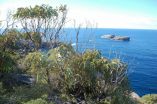(Press-News.org) Soon, many will turn back the hands of time as part of the twice-annual ritual of daylight savings time. That means remembering to change the alarm clock next to the bed, which will mean an extra hour of sleep before getting up in the morning.
But for some diabetics who use insulin pumps, Saleh Aldasouqi, associate professor of medicine at Michigan State University, suggests that remembering to change the time on this device should be the priority.
"Some diabetes patients who use insulin pumps may forget to change the clock that is found in these devices," said diabetes expert Aldasouqi. "Forgetting to change the time can result in insulin dosing errors that can be harmful."
His article can be found in the November issue of the Journal of Diabetes Science and Technology.
Dosing errors could cause too little or too much insulin being delivered at the right time for these patients.
Too much insulin produces hypoglycemia, which could be severe and trigger seizures, fainting spells or coma. Hyperglycemia is a result of too little insulin being delivered and in the short term isn't as harmful as hypoglycemia. Early effects of hyperglycemia may include tiredness and frequent urination, yet longer-term effects could cause the body to become acidic, known as diabetic ketoacidosis, and could also produce life-threatening complications.
Aldasouqi said he's had a number of patients come into his office who have forgotten to make the time change or in other cases, haven't adjusted the clock after changing the pump battery. He's also come across additional issues in his research such as health providers finding incorrect a.m. and p.m. settings.
"At this point, I haven't seen a fatal error occur, but why wait?" he said. "That's why it's important to raise awareness about this issue now and encourage physicians and patients alike to make sure these clocks are set up correctly at all times."
There are two forms of insulin delivery methods, basal and bolus. Basal insulin therapy helps patients with diabetes control blood sugar in steady amounts throughout the day and night, while bolus therapy releases insulin in bursts around meals.
A major concern is those receiving the bolus therapy may be affected more significantly if timing is off.
"Since this delivery method is timed around meals, if a patient eats lunch around noon, they'll get their burst of insulin at the wrong time," he said. "If it's too much or too little, it could send them to the hospital or worse."
Currently, insulin pump technology lags behind and doesn't have clocks that automatically adjust. GPS technology could be used to help solve this problem, but is considered controversial due to privacy concerns.
For now, Aldasouqi said the responsibility is on the patient and also on the medical community to educate patients and make sure pumps are set correctly.
"The implications of remembering to change the clock in these devices means so much more than just remembering to adjust the alarm clock for that extra hour of sleep," he said. "As a physician, I'm going to do what I can to make sure patients are safe."
INFORMATION:
Michigan State University has been working to advance the common good in uncommon ways for more than 150 years. One of the top research universities in the world, MSU focuses its vast resources on creating solutions to some of the world's most pressing challenges, while providing life-changing opportunities to a diverse and inclusive academic community through more than 200 programs of study in 17 degree-granting colleges.
Could daylight savings time be a risk to diabetics?
2014-10-30
ELSE PRESS RELEASES FROM THIS DATE:
Is space tourism safe or do civilians risk health effects?
2014-10-30
Rochelle, NY, October 30, 2014—Several companies are developing spacecraft designed to take ordinary citizens, not astronauts, on short trips into space. "Space tourism" and short periods of weightlessness appear to be safe for most individuals according to a series of articles on space biomedicine published in New Space, a peer-reviewed journal from Mary Ann Liebert, Inc., publishers. The articles are available free on the New Space website until November 30, 2014.
James Vanderploeg, MD, MPH and colleagues, University of Texas Medical Branch, Galveston, coauthored ...
NASA sees Cyclone Nilofar looking more like a comet than a tropical cyclone
2014-10-30
Tropical Cyclone Nilofar was closing in on the border between Pakistan and northwestern India on Oct. 30 when NASA's Terra satellite passed overhead from space. Wind shear continued to affect the storm making it appear more like a comet with a tail, than a tropical cyclone.
The MODIS or Moderate Resolution Imaging Spectroradiometer instrument that flies aboard NASA's Terra satellite captured a visible image of Nilofar on Oct. 30 at 06:35 UTC (2:35 a.m. EDT). Nilofar was still being affected by southwesterly wind shear, which was blowing the clouds and showers to the northeast. ...
CHEST lung cancer experts present policy statement to CMS Committee on Coverage
2014-10-30
VIDEO:
Dr. Gerard Silvestri gives background on lung cancer screening recommendations.
Click here for more information.
October 30, 2014, Glenview, Illinois -- As the Centers for Medicare & Medicaid Services (CMS) Committee on Coverage studies the decision to cover lung cancer screening for eligible individuals, today's Online First section of the journal CHEST published Components for High Quality Lung Cancer Screening: American College of Chest Physicians and American Thoracic ...
Clinical practice guidelines address multimodality treatment for esophageal cancer
2014-10-30
Chicago, October 30, 2014 – The Society of Thoracic Surgeons (STS) has released new clinical practice guidelines for treating cancer of the esophagus and gastroesophageal junction (area where the esophagus meets the stomach).
The guidelines, published in the November 2014 issue of The Annals of Thoracic Surgery, include nine evidence-based recommendations that address issues related to multimodality care, including neoadjuvant therapy (chemotherapy and radiation therapy given prior to surgery). The goal of this therapy is to reduce the extent of cancer before an ...
Molecular tumor markers could reveal new therapeutic targets for lung cancer treatment
2014-10-30
Chicago, October 30, 2014—Analysis of 607 small cell lung cancer (SCLC) lung tumors and neuroendocrine tumors (NET) identified common molecular markers among both groups that could reveal new therapeutic targets for patients with similar types of lung cancer, according to research presented today at the 2014 Chicago Multidisciplinary Symposium in Thoracic Oncology. The Symposium is sponsored by the American Society of Clinical Oncology (ASCO), the American Society for Radiation Oncology (ASTRO), the International Association for the Study of Lung Cancer (IASLC) and ...
Young adults ages 18 to 26 should be viewed as separate subpopulation in policy and research
2014-10-30
WASHINGTON – Young adults ages 18-26 should be viewed as a separate subpopulation in policy and research, because they are in a critical period of development when successes or failures could strongly affect the trajectories of their lives, says a new report from the Institute of Medicine and National Research Council. The committee that wrote the report found that young adults' brains and behaviors continue maturing into their 20s, and they face greater challenges achieving independence than their predecessors did, have lengthened pathways into adulthood, and are ...
University of Tennessee study finds saving lonely species is important for the environment
2014-10-30
The lemur, Javan rhino and Santa Cruz kangaroo rat are all lonesome animals. As endemic species, they live in habitats restricted to a particular area due to climate change, urban development or other occurrences.
Endemic species are often endangered, and a University of Tennessee, Knoxville, study finds that saving them is more important to biodiversity than previously thought.
Joe Bailey, associate professor in the Department of Ecology and Evolutionary Biology, and his colleagues from the University of Tasmania in Australia looked at endemic eucalyptus found in ...
Post-operative radiation therapy improves overall survival for patients with resected NSCLC
2014-10-30
Chicago, October 30, 2014—Patients who received post-operative radiation therapy (PORT), radiation therapy after surgery, lived an average of four months longer when compared to the patients who had the same disease site, tumor histology and treatment criteria and who did not receive PORT, according to research presented today at the 2014 Chicago Multidisciplinary Symposium in Thoracic Oncology. The Symposium is sponsored by the American Society of Clinical Oncology (ASCO), the American Society for Radiation Oncology (ASTRO), the International Association for the ...
Active, biodegradable packaging for oily products
2014-10-30
This news release is available in Spanish. The increase in the presence of plastic in our lives is an unstoppable trend due to the versatility of this material. So innovation in the packaging industry has been focusing on the development of new, more sustainable, economically viable materials with enhanced properties and which also perform the functions required by this sector: to contain, protect and preserve the product, to inform the consumer about it and to facilitate the distribution of it. Traditional containers protect the product and, what is more, are cheap ...
Medicare costs analysis indicates need to decrease use of biopsies as diagnosis tool for lung cancer
2014-10-30
Chicago, October 30, 2014—Biopsies were found to be the most costly tool prescribed in lung cancer diagnosis, according to research presented today at the 2014 Chicago Multidisciplinary Symposium in Thoracic Oncology. The Symposium is sponsored by the American Society of Clinical Oncology (ASCO), the American Society for Radiation Oncology (ASTRO), the International Association for the Study of Lung Cancer (IASLC) and The University of Chicago Medicine.
The study examined the utilization rates and estimated the Medicare costs of the lung cancer diagnostic workup ...





